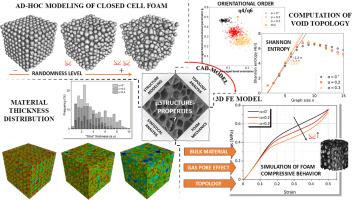Physically-based modeling of polymer foam microstructures: from realistic cellular microstructures and their variabilities to mechanical properties
IF 6
2区 工程技术
Q2 MATERIALS SCIENCE, MULTIDISCIPLINARY
引用次数: 0
Abstract
It is generally agreed that an efficient model for predicting the mechanical behavior of solid foams should present microstructural features similar to real ones. However, most theoretical results in foam micro-mechanics are based on periodic space-filling unit-cell which do not reflect the inherently random nature of real foams. The Kelvin cell or the Weaire-Phelan (WP) structure are by far the most used and yet they are only found in specialised foam. The present study therefore uses a versatile approach based on a thermodynamic description of interacting bubbles growth to produce representative volume elements of closed-cell foams with a wide variety of morphologies. Using a small set of parameters, one can build morphologies with local features specific to non-equilibrium foams. The behavior of the internal gas phase during the formation process is also modelled while assuming the absence of diffusion in the continuous medium. A sequence of mechanical micro-models is developed to study the complete compressive response ranging from the initial elastic response followed by the extensive plateau stress all the way up to the densification zone. An advanced structural analysis applied to solid foams is performed. The results are discussed in view of randomness of the cellular microstructure, anisotropic cell shape effects and inner gas pressure effect. Using regression-based approaches we attempted to build a framework capable of yielding cautious but meaningful conclusions about the relationship between topological parameters and mechanical properties. This is a major improvement over previous studies which lack variability in topological arrangement for 3D representative volume elements or which use periodic boundary conditions known to influence the way macroscopic instabilities develop.

基于物理的聚合物泡沫微结构建模:从现实的细胞微结构及其力学性能的变化
人们普遍认为,预测固体泡沫力学行为的有效模型应该呈现与真实泡沫相似的微观结构特征。然而,大多数泡沫微观力学的理论结果都是基于周期性的空间填充单元格,这并不能反映真实泡沫固有的随机性。开尔文细胞或Weaire-Phelan (WP)结构是迄今为止使用最多的,但它们只在专门的泡沫中发现。因此,本研究采用一种基于相互作用气泡生长的热力学描述的通用方法,以产生具有各种形态的闭孔泡沫的代表性体积元素。使用一小组参数,可以构建具有非平衡泡沫特定局部特征的形态。在假定连续介质中没有扩散的情况下,也对形成过程中内部气相的行为进行了建模。建立了一系列力学微观模型,研究了从初始弹性响应到广泛的高原应力一直到致密化区的完整压缩响应。对固体泡沫进行了先进的结构分析。从细胞微观结构的随机性、细胞形状的各向异性效应和内部气体压力效应等方面对结果进行了讨论。使用基于回归的方法,我们试图建立一个框架,能够对拓扑参数和力学性能之间的关系得出谨慎但有意义的结论。这是对以前的研究的重大改进,以前的研究缺乏三维代表性体积元素的拓扑排列的可变性,或者使用已知的周期性边界条件来影响宏观不稳定性的发展方式。
本文章由计算机程序翻译,如有差异,请以英文原文为准。
求助全文
约1分钟内获得全文
求助全文
来源期刊
CiteScore
9.80
自引率
9.40%
发文量
276
审稿时长
52 days
期刊介绍:
The aim of Journal of The Mechanics and Physics of Solids is to publish research of the highest quality and of lasting significance on the mechanics of solids. The scope is broad, from fundamental concepts in mechanics to the analysis of novel phenomena and applications. Solids are interpreted broadly to include both hard and soft materials as well as natural and synthetic structures. The approach can be theoretical, experimental or computational.This research activity sits within engineering science and the allied areas of applied mathematics, materials science, bio-mechanics, applied physics, and geophysics.
The Journal was founded in 1952 by Rodney Hill, who was its Editor-in-Chief until 1968. The topics of interest to the Journal evolve with developments in the subject but its basic ethos remains the same: to publish research of the highest quality relating to the mechanics of solids. Thus, emphasis is placed on the development of fundamental concepts of mechanics and novel applications of these concepts based on theoretical, experimental or computational approaches, drawing upon the various branches of engineering science and the allied areas within applied mathematics, materials science, structural engineering, applied physics, and geophysics.
The main purpose of the Journal is to foster scientific understanding of the processes of deformation and mechanical failure of all solid materials, both technological and natural, and the connections between these processes and their underlying physical mechanisms. In this sense, the content of the Journal should reflect the current state of the discipline in analysis, experimental observation, and numerical simulation. In the interest of achieving this goal, authors are encouraged to consider the significance of their contributions for the field of mechanics and the implications of their results, in addition to describing the details of their work.

 求助内容:
求助内容: 应助结果提醒方式:
应助结果提醒方式:


